

If you're planning to build a new house, it is important to do your research on more than just the home’s aesthetics. There are various types of foundations, so you should consider the different foundation options to prevent costly waterproofing problems down the line in your basement or crawl space. House foundation types should be evaluated prior to construction to maximize the project’s timeline and manage homeowners’ long-term maintenance expectations.
This blog post will help homebuilders and homeowners alike to understand the crawl space and basement foundation types for homes, including poured concrete and CMU foundations, and learn why Insulated Concrete Forms (ICFs) are the preferred alternative.
In residential construction, foundations most commonly use concrete, but there are three primary methods to building concrete foundations:

A concrete block foundation or concrete block basement involves stacking cinder blocks, or CMU blocks, to create the structural basis of the home. In some cases, you'll see CMU construction extend up the basement to the rest of the exterior walls for a concrete block house.
These CMU walls typically require a parge coat be applied to the exterior surface so there is a smooth monolithic surface for the waterproofing membrane to be applied to. CMUs are porous and therefore require exterior waterproofing to prevent crawl space or basement leaks. Additional interior insulation is also necessary to keep these areas comfortable, as air leakage through the below-grade walls is an easy way to decrease a home’s energy efficiency and raise heating and cooling costs. Note that improper installation can also trap moisture between the insulation and foundation wall, leading to mold growth.
Poured foundations, also known as cast-in-place foundations, are incredibly strong but can be time-intensive to do right. They also require added steps to remove the forms and install waterproofing and interior insulation to keep any basement or crawl space water- and air-tight. See the typical heat loss of traditional poured concrete basements and wood-framing.
Insulation is most effective when placed on the exterior of the foundation wall and should be continuous from the top of the footing to the top of the wall. This above-grade portion of the foundation commonly experiences heat loss, so insulating this area helps improve the thermal efficiency of the concrete to keep the house cool in the summer and warm in the winter.
A foundation constructed with stay-in-place Insulated Concrete Forms provides the strength of a monolithic concrete core with built-in continuous exterior insulation for a streamlined construction process and energy-efficient building envelope. Insulated Concrete Forms not only comply with modern energy and building codes, but they often exceed them for a higher performing basement or crawl space. Keep reading to learn more about the benefits of ICF concrete foundations.
 Basements and crawl spaces have long been susceptible to dampness, leading to musty odors, heat loss and costly waterproofing repairs. Insulated Concrete Form foundations change the narrative by easily supplying the durability of a concrete foundation with two sides of continuous insulation. An ICF foundation results in a drier and more sustainable basement or crawl space that remains structurally sound for the life of the home.
Basements and crawl spaces have long been susceptible to dampness, leading to musty odors, heat loss and costly waterproofing repairs. Insulated Concrete Form foundations change the narrative by easily supplying the durability of a concrete foundation with two sides of continuous insulation. An ICF foundation results in a drier and more sustainable basement or crawl space that remains structurally sound for the life of the home.
Unlike other concrete foundations, which require separate framing and basement wall insulation, ICFs integrate both into one seamless system. This speeds construction and saves labor costs, while resulting in a residential foundation that performs substantially better than other methods.
Joe Harnois of Atlantic Builders Supply notes that today’s changing workforce is impacting the building methods used. “No one's entering into the concrete industry.” he explained. “In order for builders and developers to get foundations in the ground, they're looking for alternative ways of doing it. And ICF is a great way for them to do that.”
Insulated Concrete Forms also help mitigate weather challenges during construction. In warmer months, the ICF insulation holds in the moisture from the concrete, which allows the concrete to continue to hydrate and results in a higher concrete PSI for a stronger wall. In the winter, when concrete could have difficulty curing due to the cold temperatures, the ICF blocks capture and redistribute the heat generated from the exothermic concrete curing process, so the concrete cures properly. With no cold weather delays, builders can construct ICF walls year-round.
The time-saving benefits extend to the homeowners too. Anthony Fiorello, a homeowner in New England, was surprised to find that his ICF home foundation was completed in just three days, a fraction of the time compared to other foundation methods. “The coolest thing to me is that it was done so quickly. I came by the first morning and the layout got started and then I came back later that afternoon and there was 50% of it already done,” he said.

Conventional basements and crawl spaces are notorious for moisture issues and poor air quality that leave them feeling musty and damp. This is often due to the high vapor permeance of these foundation materials.
ICFs eliminates problems with humidity and air leaks by creating an air-tight environment that stays dry. Nudura ICFs act as a Class II Vapor Barrier with a perm rating between .01 and 1.0 perms. Therefore, ICF basements and crawl spaces maintain a consistent interior temperature and eliminate drafts to improve homes’ indoor air quality and energy usage. This energy efficiency also reduces a homeowner’s utility costs as heating and cooling systems do not have to operate as frequently to compensate for basement and crawl space temperature fluctuations.
Proper installation is key to maximizing the benefits of Insulated Concrete Form foundations, basements and crawl spaces. While ICF wall systems are designed for efficiency, contractors new to ICFs may face a slight learning curve. To address this, Nudura offers online and in-person basic installer trainings and on-site support throughout both residential and commercial builds.
If a building plan already has a block or cast-in-place foundation designed for the basement or crawl space, it is not too late to change the building method to ICFs. Kody Horvey of Up to Kode explained that, “It’s not that hard to transition from one building process to the next. Everything else is very similar. What is different is the efficiency and the effectiveness of an ICF system.”
Some contractors may want to start their ICF journey by building an Insulated Concrete Form foundation and tying it into the wood framing above grade. That connection is simple enough to do, but for those who want to maximize the benefits of ICFs, it is even easier to take the ICF walls all the way to the roof.
As you look to construct the foundation of a house, it is important to evaluate all the different home foundation types. ICFs are changing the future of basement and crawl space construction, solving many of the problems associated with common block and poured walls and foundations. For a long-lasting and climate-controlled basement or crawl space, Insulated Concrete Forms are the way to go for new foundation construction.
With proper education in the construction industry, ICFs are easy for builders to adapt into their scope of work. As Ken Lynch of Nudura says simply, “Once you compare a building with Insulated Concrete Forms versus traditional foundations, when you look at the cost, the speed, the peace of mind, lower energy rates…why wouldn't you build with Insulated Concrete Forms?”
To explore other ways to use ICF construction, visit this blog post on eco-friendly applications of ICFs.